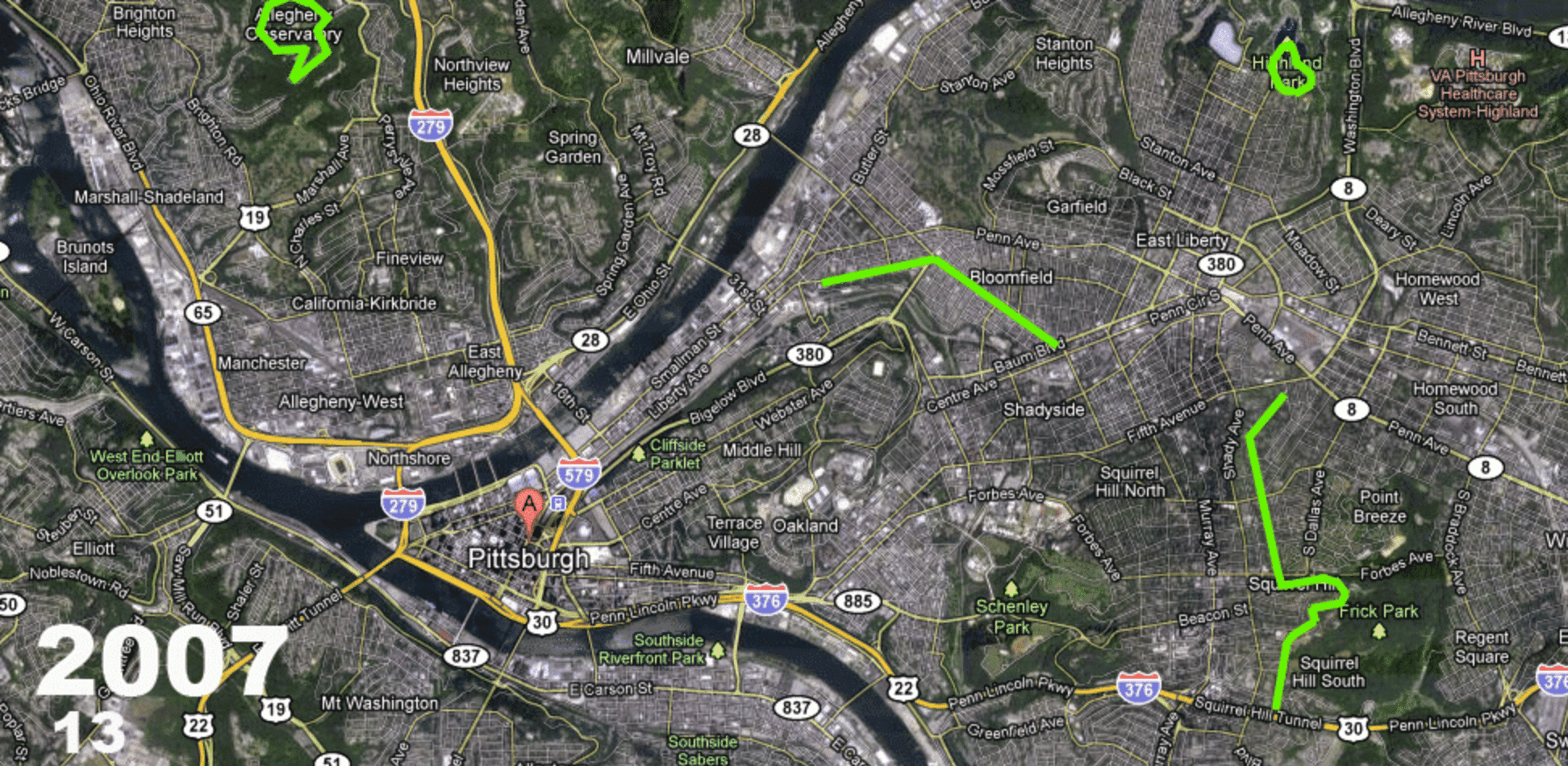
Happy 10th Birthday to the Liberty Ave Bike Lanes! (Free Cake)
Celebrate the Liberty Ave Bike Lane’s 10th Birthday on Monday, June 26. Join BikePGH, Bloomfield Livable Streets and Better Streets Lawrenceville as we wish happy birthday to the Liberty Ave Bike Lanes. We’ll be at the intersection of Liberty Ave and Millvale Ave in Bloomfield, giving away free birthday cake to any bicyclist riding in the bike lanes from 5:00pm to 7:00pm (while cake supplies last). Afterwards, join us for a happy hour at Caliente Pizza House, 4624 Liberty Ave.
Liberty Ave bike lanes: A lesson in the history of Pittsburgh’s bike infrastructure
Way back in 2007, the only bike lanes in the City of Pittsburgh were the loops in Highland and Riverview Parks, and the lengthy bike lanes on Beechwood Blvd. The City installed these lanes in the early 80s, and followed up and created several bike lane planning documents, but never moved into action on actual implementation.
Enter BikePGH. Starting in 2002, one of our first projects was figuring out how to install our “3 Rivers” bike racks in the public right-of-way. The City had no protocol for installing bike racks, so this exercise helped us make connections within City government to begin the hard work of making our streets safer. However, Mayor Tom Murphy, who deserves credit for creating our Riverfront Trails system, was less than enthusiastic about bike infrastructure on the streets themselves.
We did persist, and continued to push for on-street bike lanes, especially ones that were commuter-oriented, outside of a park. Eventually, under former Mayor Luke Ravenstahl’s Department of City Planning and Public Works, a plan was put together to add bike lanes and shared lane markings, or “sharrows” to Liberty Ave, from Bloomfield to Lawrenceville. The lanes were to become the first “commuter-oriented,” ie not recreation-oriented, bike lanes, connecting city neighborhoods.

Pittsburgh’s bike lanes in 2007
With a plan hatched, we then began one of our first forays into community engagement, as well as our first taste of “bikelash.” The initial plans called for installing bike lanes from Heron Ave to 40th St, and then pick up with sharrows from Ella St to Baum Blvd through the business district. For some reason, there were no design changes at the Bloomfield Bridge intersection. In 2007, sharrows were technically not legal, and only a few cities had used them as they were still under an “experimental status.” The Federal Department of Transportation allowed municipalities to obtain permission to install them, but they had to follow up with some research about their utility and safety.
Prior to the installation, the City hosted their first public meeting about a bike project, to a packed room in Bloomfield. Lots of people showed up in support of the project, but there were also lots of people who thought that we shouldn’t change anything or provide any safety accommodations for people on bikes. Not dissimilar to today’s debate, the conversation mostly revolved around the larger concept of promoting bicycling in general, which was not surprising as it was the first time that the City went down this road.
Ultimately, the City decided to go ahead and install the bike lanes, and ten years later, we have yet to see the collapse of the Bloomfield business district, or any other doom and gloom scenarios that were argued at the public meeting.
However, as time went on, it became clear that the sharrows between Ella St and Baum Blvd were not really doing too much to help people on bikes. While serving the purpose of allowing the City to dip their toe in the water, so to speak, we needed to aim for a better design through the business district. Since the initial Liberty Ave install, the City had put bike lanes all over town, to modest success, and little bikelash. By 2011, Liberty Ave needed to be repaved, and the City turned the sharrow design into legitimate bike lanes. However, the chaotic area spanning a block on each side of the Bloomfield Bridge intersection, where clarity was needed the most, still had nothing to guide bikes through.
In 2013, the City began looking to experiment with green pavement markings, a treatment that had gained favor nationwide to help bring attention and visibility to intersections and areas of potential conflict between bikes and cars. Through working with BikePGH, the City secured funding to reduce the number of lanes through the intersection, and added a highly visible “green lane” to highlight where the ramps to the bridge and to Main St cross the bike lanes. While helpful to bicyclists, the intersection still needs help, and hopefully one day, we will see a design that includes a safer intersection for cars, bikes and pedestrians alike.
The story of Liberty Ave is also the story of Pittsburgh’s bike lane development in microcosm. It was also the first on-street infrastructure project that BikePGH advocated for and won. A decade later, Pittsburgh now has about 77 miles of bike lanes and sharrows, and it’s almost hard to remember what Liberty Ave was like before there were no bike lanes, no bike racks, no bike share stations, and few bicyclists. Today, it has become a normal part of the neighborhood, and we think, helped make the neighborhood more vibrant and safer.
Sign up for Bike Pittsburgh’s newsletter, The Messenger, to get the latest news on events, bike and pedestrian infrastructure, and fun, delivered straight to your inbox. Twice monthly emails, no spam.
